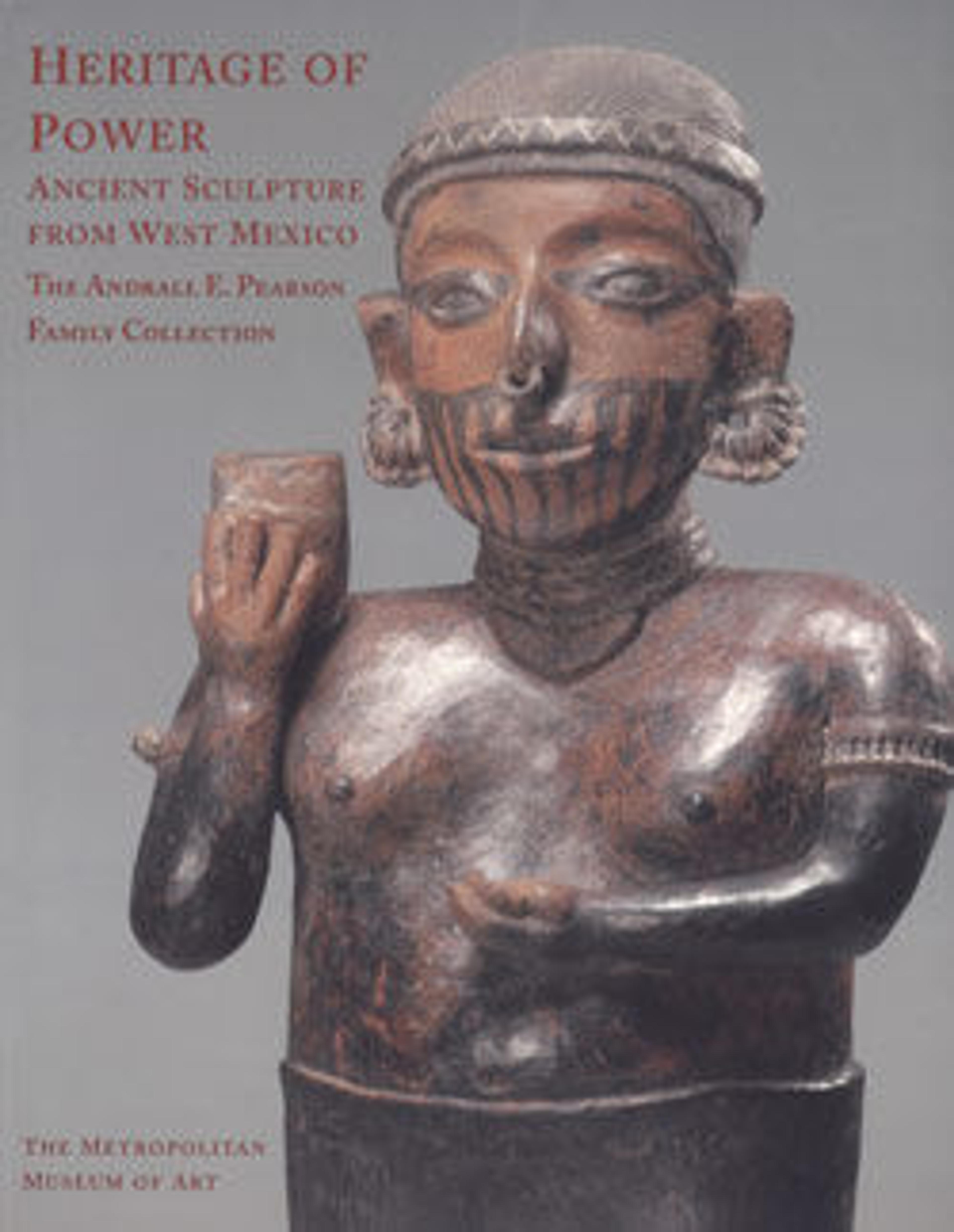Standing female figure
Throughout West Mexico, highly naturalistic ceramic sculptures drawn from daily life were placed in tombs to accompany the dead. These representations of plants, animals, and people, together with narrative scenes of village life (see MMA 2015.306), created a recognizable world for the deceased to continue life in a new realm.
This female figure stands with one hand raised to her left shoulder, a gesture of unknown significance. Her broad feet provide a stable base, allowing her to stand upright. The figure’s breasts are exposed, her upper body adorned with beaded necklaces, nose ornaments, earspools, and several painted or tattooed body designs. Her skirt features woven patterns that incorporate dots, crosses, and diagonal lines.
Few textiles from ancient Mesoamerica have survived, but artworks like this one provide valuable insights into their use and appearance. West Mexico’s weavers utilized various structural techniques on and off the loom, including hand netting, to create designs that reflect the geometry of the weaving process itself. This can be seen in the diamond-like patterning of the skirt. Using only white and red slip the artist suggests the various textures of the woven cloth depicted. Cloth colored with dyes sourced from plants, insects, and minerals was manipulated in myriad ways to create items of dress and ornament. Textiles were wrapped around the lower body to form loincloths and skirts, and narrow, twisted bands of cloth were wound and tied to secure head coverings. Even neck ornaments were sometimes delicately woven and beaded.
This figure is strikingly similar to another in the museum’s collection (see MMA 2005.91.8). The two, while differing in size, were almost certainly created in the same workshop. The materials and techniques are the same, and the figures’ dresses and ornaments nearly identical, suggesting that they could have been created for members of the same extended family. Each may once have been half of a male/female pair, like those often found in West Mexican tombs (see MMA 2005.91.2, 3).
Patricia J. Sarro, 2025
Further reading
Baumbach, Otto Schöndube. EL HORIZONTE CLASICO: Las Culturas de Jalisco, Colima y Nayarit / THE CLASSIC HORIZON: The Cultures of Colima, Jalisco, and Nayarit. Artes de México, no. 119 (1969): 23–68. http://www.jstor.org/stable/24315718.
Butterwick, Kristi. Heritage of Power: Ancient Sculpture from West Mexico: The Andrall E. Pearson Family Collection. New York, New Haven, London: The Metropolitan Museum of Art, 2004.
</p>Cabrero G., Ma. Teresa and Carlos López Cruz. Las Tumbas de tiro de El Piñon, En El Cañon de Bolaños, Jalisco, Mexico. Latin American Antiquity 9, no. 4 (1998): 328–41. https://doi.org/10.2307/3537031.</p>
Gallagher, Jacki. Companions of the Dead. Ceramic Tomb Sculpture from Ancient West Mexico. Los Angeles: University of California. 1983.
Los Angeles County Museum of Art. Sculpture of Ancient West Mexico, Nayarit, Jalisco, Colima. Los Angeles: The Los Angeles County Museum of Art, 1989.
Pickering, Robert B., and Ephraim Cuevas. The Ancient Ceramics of West Mexico: Corpse-Eating Insects and Mineral Stains Help a Forensic Anthropologist and a Chemist Determine the Authenticity of 2,000-Year-Old Figurines. American Scientist>/i> 91, no. 3 (2003): 242–49. http://www.jstor.org/stable/27858214.
Pickering, Robert B. and Cheryl Smallwood-Roberts. West Mexico: ritual and identity. Tulsa: Gilcrease Museum, 2016.
Townsend, Richard, ed. Ancient West Mexico: Art and Archaeology of the Unknown Past. Chicago: Art Institute of Chicago, 1998.
Zepeda, Gabriela, Nayarit prehispánico. In Introducción a la arqueología del Occidente de México. Mexico City: Instituto Nacional de Antropología e Historia: 2004, pp. 371-396.
Artwork Details
- Title: Standing female figure
- Artist: Tala-Tonalá artist(s)
- Date: 300 BCE–300 CE
- Geography: Mexico, Mesoamerica, Jalisco
- Culture: Tala-Tonalá
- Medium: Ceramic, slip
- Dimensions: H. 20 1/16 × W. 9 1/4 × D. 7 1/4 in. (51 × 23.5 × 18.4 cm)
- Classification: Ceramics-Sculpture
- Credit Line: Gift of The Andrall and Joanne Pearson Collection, 2005
- Object Number: 2005.91.7
- Curatorial Department: The Michael C. Rockefeller Wing
More Artwork
Research Resources
The Met provides unparalleled resources for research and welcomes an international community of students and scholars. The Met's Open Access API is where creators and researchers can connect to the The Met collection. Open Access data and public domain images are available for unrestricted commercial and noncommercial use without permission or fee.
To request images under copyright and other restrictions, please use this Image Request form.
Feedback
We continue to research and examine historical and cultural context for objects in The Met collection. If you have comments or questions about this object record, please contact us using the form below. The Museum looks forward to receiving your comments.
